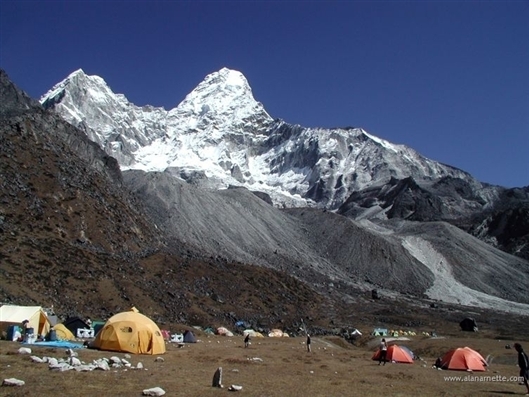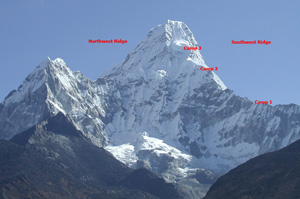
Nepal
22,494 feet 6828 meters
|
 |
Ama
Dablam FAQ Nepal 22,494 feet 6828 meters |
|||||||
|
||||||||
Ama Dablam is one of the classic Himalaya climbs. Admired by every
trekker in the Khumbu it tests all of a mountaineer's skills.
I am focusing on the Southwest Ridge since it is the normal route and
the one I took in 2000.
I am asked many questions about climbing especially since I am not a professional
climber. So here are the most popular questions with my answers.
As always, this information is based on my experience and are
my opinions so always consult with a professional before making
any serious climbing decisions.
About Ama DablamQ: Where is itA: It is located in Nepal. Ama Dablam stands tall above all the other mountain peaks in the lower Khumbu Valley. The standard itinerary is to fly to Katmandu and then on to Lukla, a tiny Himalayan village, to start the 20 mile walk to base camp. View Larger Map Q: When is it usually climbed? A: As with most Himalayan peaks, Spring is best since every day it gets warmer with less threat of snow. However since winter can still be around so it can be quite treacherous with frozen precipitation.The Fall season is just the opposite with colder days and increasingly unstable weather. I climbed in September and had great weather. Most guides climb in the Fall since they are occupied with Everest in the Spring. Q: How hard is Ama Dablam? A: It's technical. This means ropes, ice axe, crampons, ice screws, cams and jumars. The rock climbing can be 5.7 and the ice, WF4. You really need to have ice and rock climbing experience plus some high altitude experience. My personal experience was difficult but not impossible. I found the rock and ice climbing challenging - I wish I had had some deeper experience, especially on rock. Since I had the Cho Oyu experience to learn from, the altitude was not difficult, but I am glad it was not my first time above 20,000'. Q: How does Ama Dablam compare with Denali or Aconcagua? A: It is a serious technical climb where climbers need rock climbing experience at altitude in order to feel comfortable. Everything is carried on your back in your pack, not on a sled, so loads can be heavy. It shares a few long steep snow slopes like a Denali but the weather is not quite as cold in a normal year. Finally it is quite a bit more dangerous and risky than the West Butt route on Denali. It is a completely different climb from Aconcagua and not really comparable. Q: How does Ama Dablam compare with Everest or other 8,000m peaks? A: Ama Dablam is often climbed as a great climb independent of other 8000m plans. It is significantly more technical than most of the normal routes on 8000m climbs including Everest but the overall atmosphere is similar. It is a shorter climb by time. Q: Is an Ama Dablam climb dangerous? A: Absolutely. You should only attempt Ama Dablam if you have the proper experience and logistics for emergency situations. 6 climbers were killed in November 2006 when part of the large distinctive serac (the Dablam) collapsed hitting Camp 3. The Dablam has further collapsed in late 2008. As of 2012, teams continue to climb without serious incident but many choose to bypass Camp 3 and have a very, very long day form Camp 2 to the summit. Q: How many people have summited and how many people had died trying? A: An estimated 1900 people have summited and 18 have died as of 2008. Training, Gear & Communication:
Q: How did you train for this climb? Everest legend Tom Hornbein explained it to the American Lung Association this way: The lower oxygen stimulates chemoreceptors that initiate an increase in breathing, resulting in a lowering of the partial pressure of CO2 and hence more alkaline blood pH. The kidneys begin to unload bicarbonate to compensate. Though this adaptation can take many days, up to 80% occurs just in the first 48 to 72 hours. There are many other physiologic changes going on, among them the stimulus of low oxygen to release the hormone, erythropoietin to stimulate more red blood cell production, a physiological and still acceptable form of blood doping that enhances endurance performance at low altitudes. Adaptive changes are not always good for one’s health. Some South American high altitude residents can have what’s called chronic mountain sickness, resulting from too many red blood cells; their blood can be up to 84-85% red blood cells. The increased blood viscosity and sometimes associated pulmonary hypertension can result in right heart failure. You cannot do much to acclimatize while at a low altitude but there are companies that claim to help the acclimatization process through specially designed tents that simulate the reduced oxygen levels at higher elevations. I have no personal experience with these systems but you can find more details at the Hypoxico website. They cost about $7,000 or can be rented for about $170 a week. Outside Magazine posted an article in 2013 questioning their effectiveness. Q: What kind of equipment did you use? Expedition BasicsQ: Which route is most popular?A: The Southwest ridge is the most popular. However with the recent instability of the Dablam, this route has become deadly. A modification was put in during the Fall of 2008 which takes the route further to the right of the Dablam. This somewhat avoids the avalanche danger but now is over steep blue ice making the summit bid more difficult. As of 2012, teams continue to climb without serious incident but many choose to bypass Camp 3 and have a very, very long day form Camp 2 to the summit. Of course snow conditions are different each year thus the route will vary accordingly. The other routes include: North and Southeast Ridge. These are extremely technical and subject to avalanches and not offered by almost any commercial company. Q: How long will it take? A: 2 weeks on the mountain plus another week get to base camp and about 4 days to get back to Katmandu, depending on flights out of Lukla. Q: How much does a standard climb cost with and without a guide? A: The costs can range from $5000 to $10000 depending on who you use. If you do everything yourself cut the highest cost in half or more. See my Guide page for more details. Q: Do I need a permit to climb? A: Yes a climbing permit is required through the Nepal Ministry of Tourism of $400 per person. There are other fees for example a trash fee of $1,000. Q: Do I really need a guide for Ama Dablam? A: Some teams do not use western guides however almost everyone employs the services of Sherpas at a minimum. The route is straightforward but can be confusing especially now with the modification mentioned earlier. I would not want to navigate it by myself in harsh conditions. Also new ropes need to be fixed on the Yellow Tower and perhaps in the Grey Couloir so you must have the skills to do this if you are the first on the route. Never, ever trust old ropes. Q: Are there local guides for Ama Dablam? A: Yes. There are local logistics companies in Kathmandu that can provide local Nepalese (Sherpa) guides and base camp services. Q: How do you get on an expedition to climb Ama Dablam? A: Most reputable guides ask for your climbing resume and require some serious climbing experience. Ideally they want to see climbs of Denali or Aconcagua. But most anyone can get on a Ama Dablam commercial expedition these days without many questions so be careful who you select since you may get caught up in a mess. Q: What is involved if I plan my own climb? A: Basically everything: permits, travel, hotels, food, gear, routes, communications, emergency contentions - everything. There are local companies in Katmandu who can provide some services such as getting food or heavy tents to base camp. And some can provide a Sherpa at low costs. You can save a lot of money this way but as I said before, consider your skills in the event that something goes wrong - are you 100% self sufficient? What are your medical skills? HAPE and HACE are really possibilities on Ama Dablam - do you have the proper medicine and training to deal with it? And a hundred more questions. See my guide page for more. Again, climbing alone or in small teams is never a good idea. Saving a few thousand dollars is not worth your life. Q: What is the biggest problem most people face? A: Ama Dablam is a difficult mountain. With it's relatively low altitude for the Himalayas, some people underestimate the difficulty. However, the challenges presented by the rock and ice climbing plus the altitude creates a serious challenge for anyone. My 2000 Experience Q: Did
you summit? Q: Did
you summit? A: Yes. It was a relatively quick climb from Camp 3 and was rewarded with an amazing view of Everest, Cho Oyu and Makalu. Q: Why did you choose Adventure Consultants as a guide service
in 2000? Bottom LineAma Dablam is a fantastic climb by any definition. In many ways it is more satisfying than the 8000m climbs with the rock, ice and snow sections. But it is a very dangerous climb today (2008) with the instability of the Dablam. If you are experienced and comfortable on extreme mixed routes above 20,000' then this is a must climb. |
|